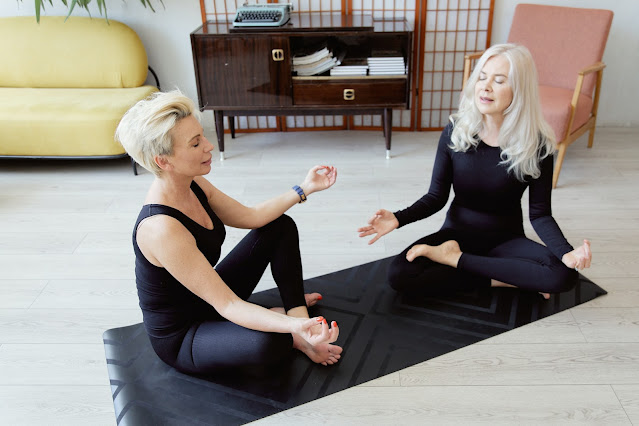Pursed Lip Breathing
 |
| Pursed Lip Breathing |
What Is Pursed Lip Breathing?
Pursed-lip breathing is a breathing technique that is used to help control shortness of breath. It involves breathing in slowly through your nose, and then breathing out slowly through pursed lips, as if you were blowing out a candle. It can help to slow down your breathing, which can make it easier to breathe and reduce feelings of shortness of breath.
This technique is commonly used for people with chronic obstructive pulmonary disease (COPD) and other lung conditions, as well as those who are recovering from surgery or suffering from anxiety or panic disorder. Pursed-lip breathing can help to improve lung function, reduce feelings of anxiety, and promote relaxation. It can also help to reduce the work of breathing and increase the amount of oxygen that reaches the body.
Pursed-lip breathing can be done at any time, but it’s especially useful when you’re feeling short of breath or when you’re engaging in activities that tend to cause shortness of breath. You can practice pursed-lip breathing in any position and it’s easy to learn, but it’s important to check with your doctor before starting if you have any health concerns.
How To Do Pursed Lip Breathing?
These are the different steps to practice the pursed-lip breathing:
- Find a comfortable position. You can either lie on your back or recline in a chair with your feet flat on the floor. It’s crucial to have a straight spine and relaxed shoulders.
- Take a deep breath in through your nose, allowing your chest and abdomen to rise.
- Pucker your lips as if you were going to whistle or blow out a candle, and exhale slowly through pursed lips.
- The exhale should be twice as long as the inhale, for example, if you inhale for a count of four, exhale for a count of eight.
- Repeat this process for several minutes, focusing on the slow and steady exhale through pursed lips.
- As you become more comfortable with the technique, you can try to inhale and exhale for a count of four, trying to make the inhale and exhale as smooth and steady as possible.
- Once you have mastered the basic technique of pursed-lip breathing, you can try incorporating it into your daily activities, such as walking, doing chores, or even during work, to help reduce shortness of breath.
It’s important to note that pursed-lip breathing may take some time to get used to, so don’t be discouraged if you don’t feel comfortable with it right away. It is also important to check with your doctor if you have any health concerns before practicing pursed-lip breathing, especially if you have any respiratory conditions.
Benefits of Pursed Lip Breathing
Pursed-lip breathing is a breathing technique that can have a number of potential benefits, particularly for people with chronic obstructive pulmonary disease (COPD) and other lung conditions, as well as those who are recovering from surgery or suffering from anxiety or panic disorder. Here are a few examples:
- Improved Lung Function – Pursed-lip breathing can help to slow down breathing and increase the amount of oxygen that reaches the body. This can lead to improved lung function and better overall health.
- Reduced Shortness Of Breath – Pursed-lip breathing can help to reduce the work of breathing and make it easier to breathe, which can reduce feelings of shortness of breath.
- Increased Air Flow – Pursed-lip breathing helps to keep the airways open for a longer period of time, which can increase the flow of air in and out of the lungs.
- Reduced Anxiety – Pursed-lip breathing promotes relaxation and alleviates anxiety, especially beneficial for individuals with COPD or other lung conditions.
- Improved Endurance – Pursed-lip breathing increases oxygen intake, enhancing endurance and facilitating physical activity.
- Better Sleep – Pursed-lip breathing can help to relax the body and mind, which can lead to better sleep quality.
- Improved Athletic Performance – Pursed-lip breathing improves body oxygenation, aiding athletes in better performance and faster recovery from exertion.
When Not To Do The Pursed Lip Breathing
- Respiratory Condition – Pursed-lip breathing may not be suitable for conditions like asthma or chronic obstructive pulmonary disease (COPD). It’s important to consult with your doctor before practicing pursed-lip breathing if you have any respiratory conditions.
- Asthma Attack – Pursed-lip breathing may be difficult to do during an asthma attack. If you’re experiencing difficulty breathing, it’s important to follow your asthma action plan and use your rescue inhaler.
- After Abdominal Surgery – If you’ve recently had abdominal surgery, pursed-lip breathing may be uncomfortable or even painful. It’s important to check with your doctor before practicing pursed-lip breathing after surgery.
- During Pregnancy – Pursed-lip breathing might not be suitable during pregnancy due to increased uterine pressure, potentially causing discomfort or harm to the baby. It’s important to consult with your doctor before practicing pursed-lip breathing during pregnancy.
- Panic Attack – Pursed-lip breathing can be challenging during a panic attack due to hyperventilation. In such instances, try other coping methods like grounding techniques and seeking professional help.
The Buteyko method may reduce the need for medication by alleviating asthma and COPD symptoms.
